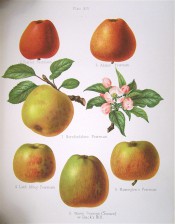Malus domestica ‘Winter Pearmain’
Fruit middle-sized, regularly shaped, tapering a little from the base to the crown, which is a little narrowed. Eye small, and closed by the short segments of the calyx. Stalk short, slender, protruding a little beyond the base. Skin a grass green, with a little colour of a livid red on the sunny side, interspersed with a few dark specks, particularly on the produce of old trees, especially those which are encumbered with a profusion of wood. Flesh pale green, firm, crisp. Juice not plentiful, but saccharine, and of a slight aromatic flavour. A dessert apple from November till March.’ [George Lindley – Orchard Guide p.84/1831].
Horticultural & Botanical History
‘A highly esteemed old English apple, suitable principally for culinary purposes, but also valuable for the dessert; it is in use from December to the end of April. The tree attains about the middle size, is a free and healthy grower, and an excellent bearer.
This is, I believe, the oldest existing English apple on record. It is noticed as being cultivated in Norfolk, as early as the year 1200, — what evidence against Mr. Knight's theory! In Blomefield's History of Norfolk, there is mention of a tenure in that county by petty serjeanty, and the payment of two hundred pearmains, and four hogsheads of cider of pearmains into the Exchequer, at the feast of St. Michael, yearly. It is the original of all the Pearmains, a name now applied to a great variety of apples. Much doubt has existed as to the origin of this word, and in a communication to the Gardener's Chronicle for 1848, I there stated what I conceived to be its meaning. The early forms in which it was written, will be seen from the synonymes above, they were Pearemaine and Peare-maine. In some early historical works of the same period, I have seen Charlemagne written Charlemaine, the last portion of the word having the same termination as Pearemaine. Now, Charlemagne being derived from Carolus magnus there is every probability that Pearemaine is derived from Pyrus magnus. The signification therefore of Pearmain is the Great Pear Apple, in allusion no doubt, to the varieties known by that name, bearing a resemblance to the form of a pear.’ [Hogg p.209/1851].
An old variety, origin unknown. Produces a large, vigorous tree and is an abundant bearer. Ripe from October to December. ‘This is a very beautiful apple and held a great favourite.’ A good dessert and culinary apple and also often used for cider. [HP].
This apple is probably the one figured as ‘Sussex Winter Permain’, ‘sometimes called locally Winter Pearmain’, in the Herefordshire Pomona [HP pl.XIV/1878].
History at Camden Park
Listed in all published catalogues [Apple no.8/1843]. This apple is mentioned twice in William Macrthur’s records. He thought highly of it.
Winter Pearmain? [The query is Macarthur’s]. April-November. Very great. A very favourite apple on account of its quality for the kitchen and for keeping. [Notebook no.9, MP A2948].
MP, Vol. 55, A 2951, diary B, 1862. Winter Pearmain ? [The query is Macarthur’s] April-November. An excellent keeping apple not of high flavour but very valuable for the kitchen and fruit [word indistinct but probably] garden. [Diary B, 1862, MP A2951].
Notes
The identity of the apple listed in the catalogues as ‘Winter Pearmain’ is uncertain but it is probably the apple described here. In Macarthur’s Notebook no.9 the name is followed by a question mark, probably indicating that Macarthur had some doubts about its identity.
Published Apr 15, 2010 - 02:39 PM | Last updated Jul 25, 2011 - 05:05 PM
| Family | Rosaceae |
|---|---|
| Category | |
| Region of origin | Garden origin, probably England |
| Synonyms |
|
| Common Name | Apple, Dessert apple, Culinary apple, Cider apple, Keeping apple |
| Name in the Camden Park Record | Winter Pearmain
|
| Confidence level | medium |


